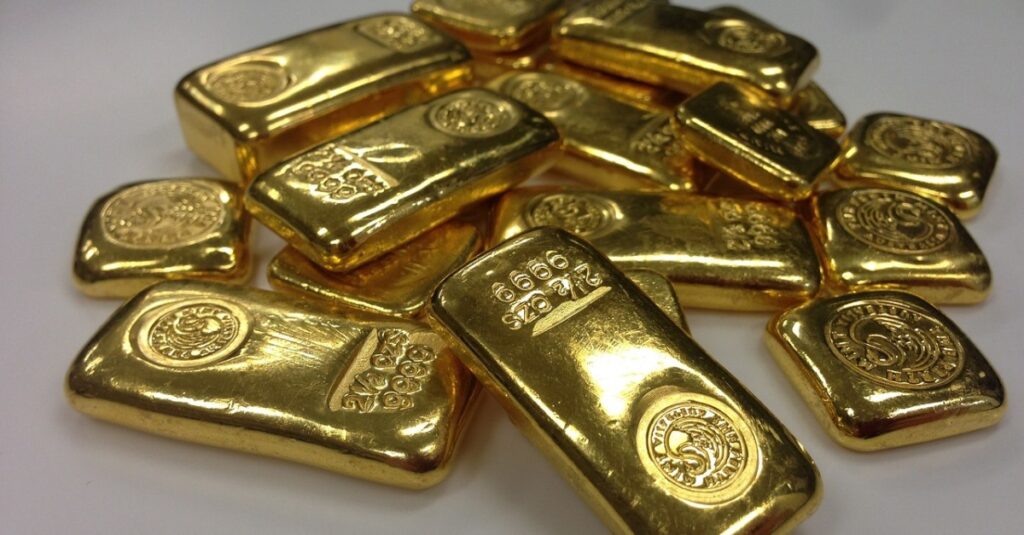This blog is Part 2 of a 4-Part Series on German Jew Werner Goldstein
Part 1 is here, Part 3 & Part 4 will be here when posted.
I never thought I would find any information on Josef’s gold counterfeiting buddy. To me, the name “Goldstein” (Goldstone) seemed too utterly made-up to be real. But, it would appear that I have been wrong. Josef was telling the truth. The Swiss Archives have provided us with four key pieces of information: (1) Werner Adolf Goldstein (full name); (2) born 21 December 1911 (birth date); (3) from Berlin (residence) and (4) Dentist (occupation). With those clues, let us begin our search.
Finding a Toehold with Werner Adolf Goldstein
First off, the Berlin birth registrations are locked for 125 years, so only those people born before 1908 have viewable birth registrations . So we have to come at Werner sideways. My first stop was the Mapping the Lives website, which lists many (if not most) of the Jewish residents of Germany from the 1939 German Minority Census. The database, in this case, is not all that helpful. While we can be confident this is our man based on his name and birth date, there is no residential address, which is unfortunate. Although… the emigration information (to Italy!?) is intriguing and hopeful. Did Werner escape the Holocaust? Time will tell.
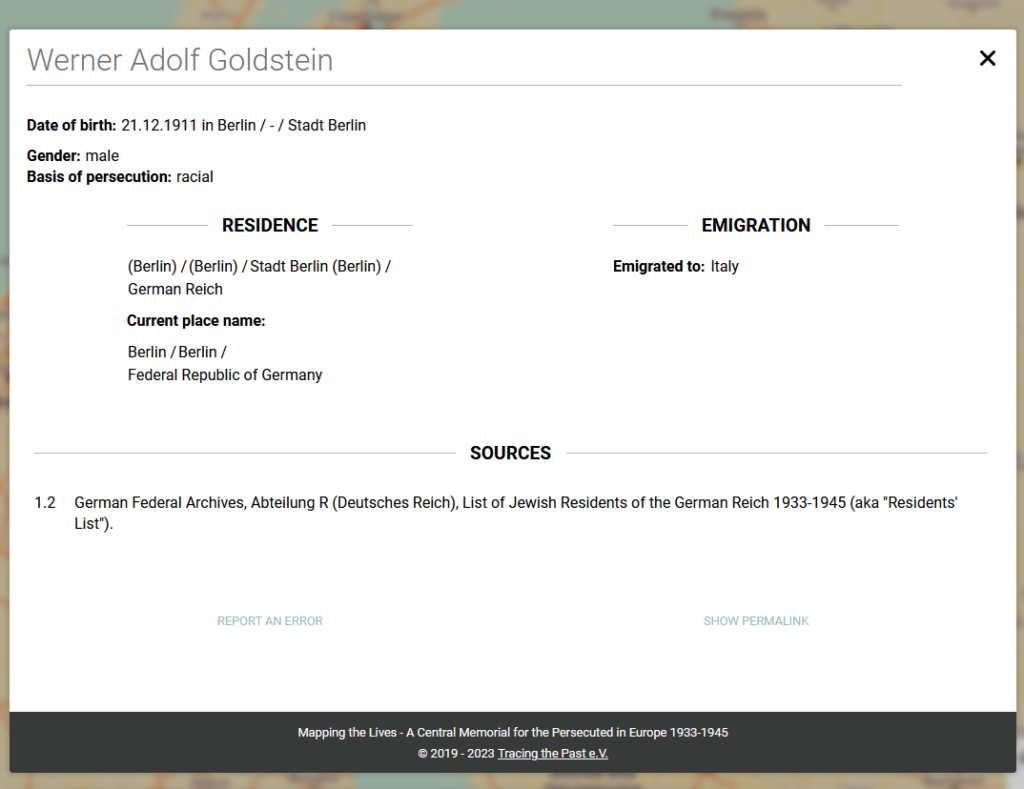
A bit more digging yielded a key document, the registry of German Jews who had their German citizenship revoked by the Nazis. Here we find Werner Adolf Goldstein, born 21 December 1911 in Berlin, a Kaufmann (businessman) by occupation, and a resident at Paristerstraße 7, Wilmersdorf, living with his parents (bei den Eltern). At last, a solid clue to his parents.
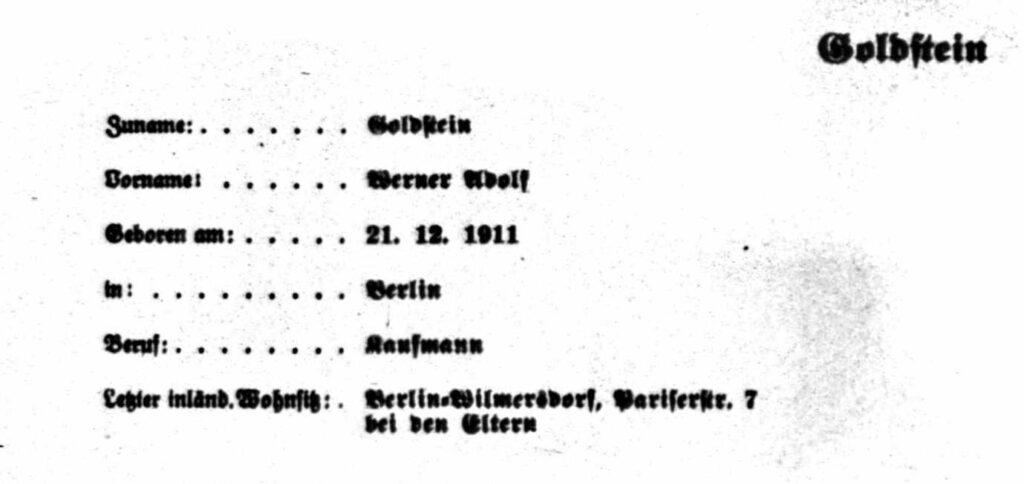
(From Ancestry site)
A systematic search of the Berlin address books from the 1920s and 1930s left me confused for a while.
Let’s start with the 1937 Phone Directory for Berlin. We find a “W. Goldstein, Americ. Dent. Surgery amerikan. Zahninst. Wilmd. Uhlandstr 96”. Essentially… W. Goldstein, ran an American Dental Surgery, or an American Dental Institute in Wilmersdorf at Uhlandstraße 96. Could this be Werner? Perhaps he really was a dentist, and not a chemist? Or was this perhaps some other Goldstein? But the dental connection is too much of a coincidence. Farther down, on that same page, we find a Werner Goldstein, commercial agent, living in the Tiergarten area. Could that be him? The reference to an American Dental Surgery, a style of cosmetic dentistry, is fascinating, because Josef too was listed as having an American Dental Surgery, something that I discussed in a previous blog post. More coincidences!
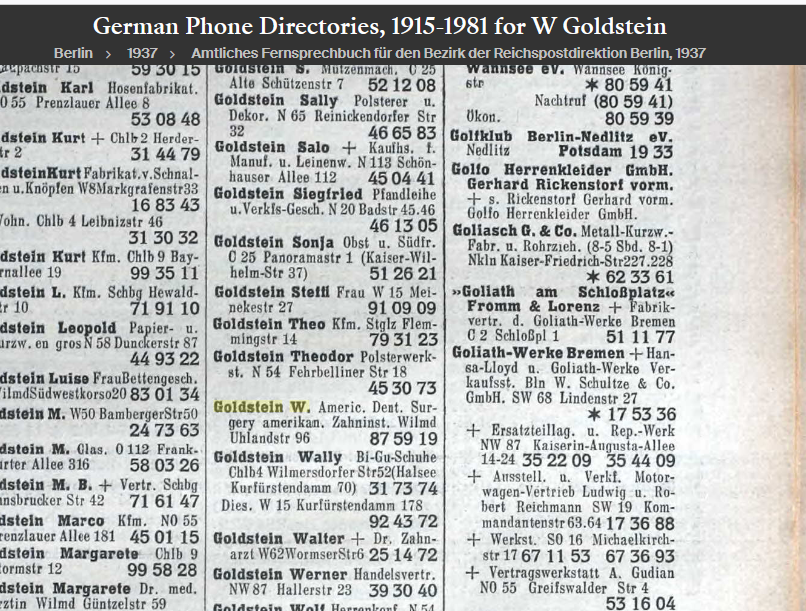
(From Ancestry site)
In reviewing other Berlin address books, it quickly became clear that Herr W. Goldstein, American Dental Surgery, could not be Werner Goldstein. The 1916 Berlin address lists Herr W. Goldstein yet again and Werner was only 5 years old at the time. Clearly too young to be a dentist. But could this mysterious Herr W. Goldstein be Werner’s father?
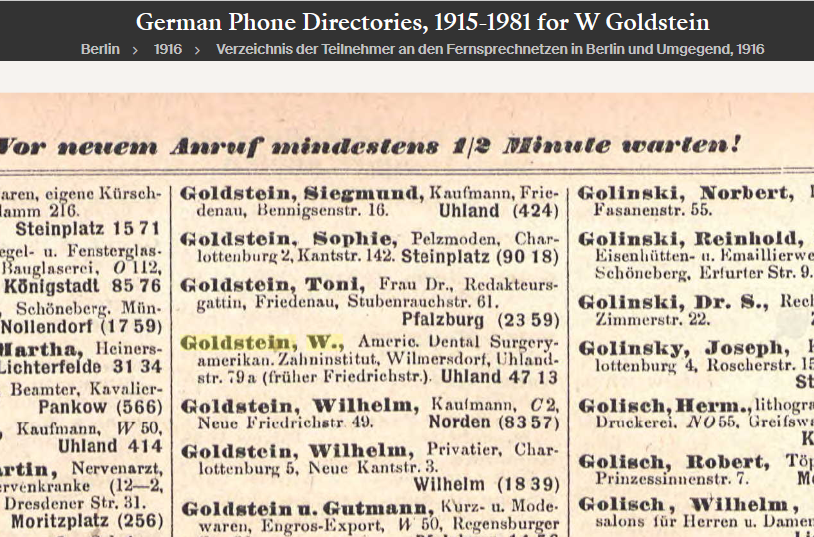
(From Ancestry site)
Indeed… in 1934, we find Herr W. Goldstein, and his American Dental Surgery, listed at Pariserstraße 7, the same address listed on Werner’s revocation of German citizenship, the address of his parents!
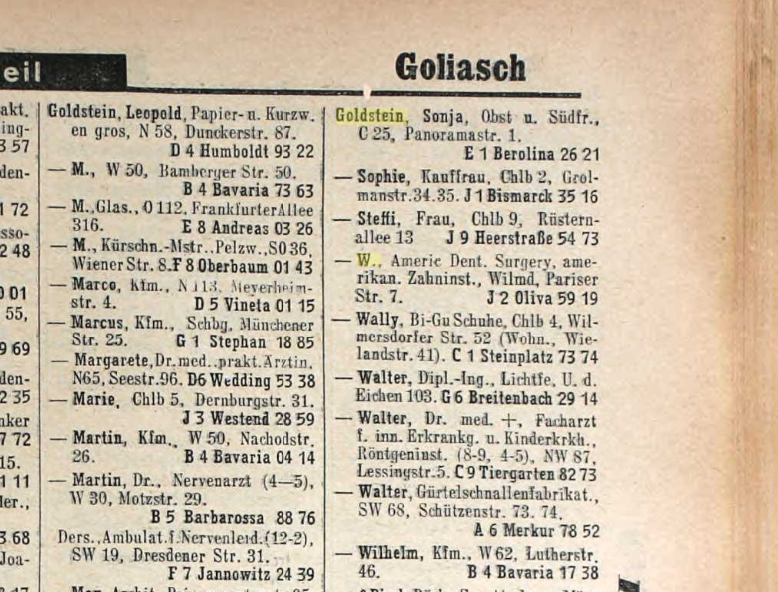
(From Ancestry site)
As for Herr W. Goldstein’s first name… a 1925 Berlin address book finally yielded the following entry (bracketed by the red marks). Our American Dental Surgery friend is Willy Goldstein and most likely Werner’s father (this is confirmed by another piece of data which we won’t touch upon until much later in our story).
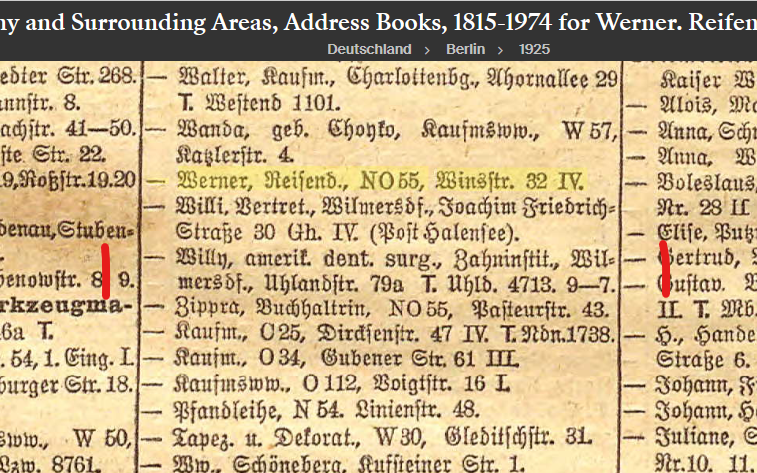
(From Ancestry site)
Family Origins of Werner Adolf Goldstein
Willy Goldstein was born 4 May, 1877, in Berlin, the first-born child of Adolf Goldstein, himself a dental technician, and his wife Natalie Perl. Adolf and Natalie would have five children in total, four of whom lived past childhood. As the eldest son, Willy obviously followed in his father’s footsteps by becoming a dentist.
While Willy had been born in Berlin, Adolf had been born in Bentschen, Posen (now Zbaszyn, Wielkopolskie, Poland) in 1846. By age 12, however, Adolf and his parents and siblings had pulled up their family roots and moved to Potsdam on the outskirts of Berlin.
Willy’s mother, Natalie Perl, had been born in Gleiwitz, Schlesien, in 1846, first appearing in the Berlin records in 1873 when she married Adolf Goldstein.
Teeth for the Middle Class
Shortly thereafter, Adolf set up his dental practice on Oranienstraße 123 in what is now the Kreuzberg area – just east of what would become Checkpoint Charlie. Adolf was not quite a dentist, but a Zahnkunstler… a dental “artist” or technician. The 1896 Berlin address book entry for Adolf is stuffed with convoluted abbreviations, but Traugott Vitz, a regular reader of this blog, kindly helped me decipher and expand on the entry.
Goldstein, A[dolf], Zahnkunstler, Atelier für Einsetzung künstliche Zähne in Gold und Kaukschuk, SW Oranienstraße 123 I.

(From Ancestry site)
So, essentially Willy’s father (and Werner’s grandfather) was a dental technician with a studio in Oranienstraße where he provided dentures. Up until the early to mid-1800s, dentures used such expensive base plate items as gold or ivory (from walrus, elephant or hippopotamus). While false porcelain teeth (and even cadaver teeth) were widely available, the problem lay in finding a durable and affordable base material to hold the teeth.
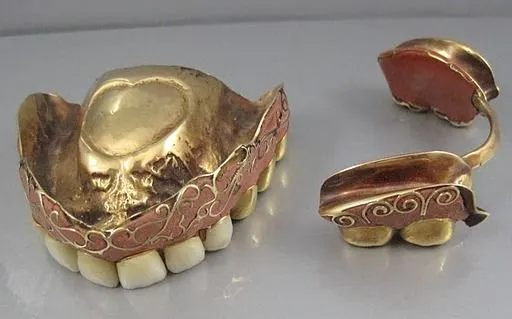
(From Care Denture Clinic site)
In the 1840s, the discovery of vulcanite (a process to harden India rubber (caoutchouc)), provided a much cheaper material for denture makers. Goldsmith Claudius Ash, in the UK, created the first set of dentures using vulcanite and suddenly dentures were within reach of the middle class!
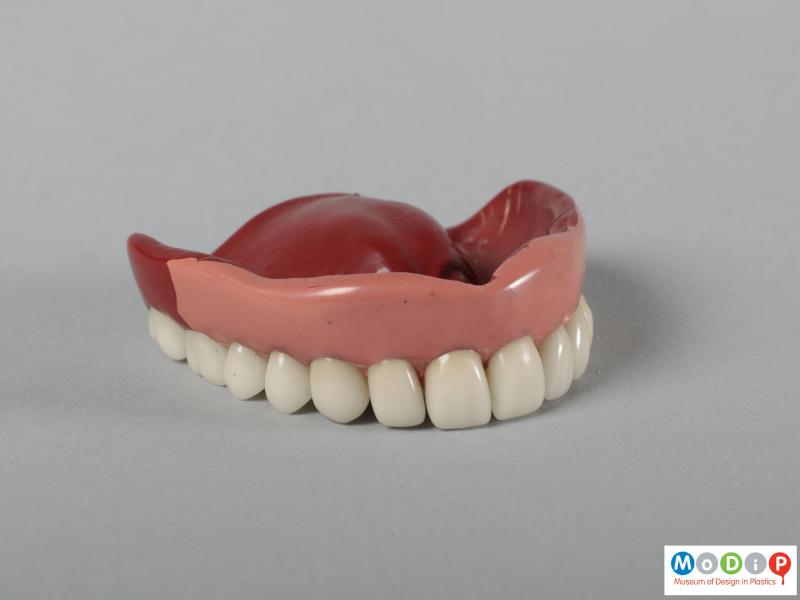
(From Museum of Design in Plastic site)
Adolf Goldstein was indeed a “dental artist”, crafting unique pieces for each of his clients. And it would appear that his son, Willy decided to follow in his father’s footsteps, albeit with a twist.
Willy Goldstein – American Dental Surgery
We already know that Willy operated an American Dental Surgery, which focused on porcelain inlays, crowns and bridges, a more cosmetic or aesthetic stream of dentistry. For much of his life, he seems to have lived a fairly sedate existence. Although, in August 1899, he may have taken the SS Barbarossa to New York to visit a cousin! While “Willy Goldstein” is not all that unique of a name, his age is a match and his occupation on the ship’s manifest is “dentist”. The following year, Willy’s father, Adolf, passed away in Berlin, on 28 December, 1900. Natalie would follow suite several years later, although her exact date of death is unknown.
Other than that we don’t know too much about Willy. We don’t even know when he married his wife, Emilie Spiegel (born 30 August 1875), but we can presume it would have happened before Werner’s birth on 21 December 1911. As for Emilie, all we know is her birth date and location, Ettlingen, Karlsruhe. Without a marriage registration for Willy and Emilie, a document that would name her parents, it is challenging to trace her.
So, we have Willy and Emilie living in Berlin, with Willy operating an American Dental Surgery. He appears to have been a dentist as early as 1899 and perhaps his trip to America was to get trained in the art of American cosmetic dentistry. After his father passed away in 1900, Willy seems to have taken over the dental practice at Oranienstraße 123. By 1908, he had moved his practice a few blocks west to Kochstraße 8. And by 1911, the year that Werner was born, Willy and Emilie had moved again, just around the corner to Friedrichstraße 218. By 1915 the family had moved again, this time to the up-and-coming Berlin district of Wilmersdorf on Uhlandstraße 79a.
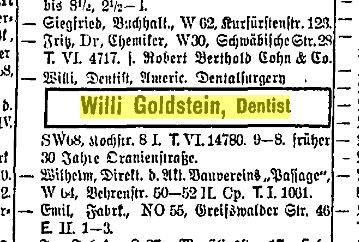
(From Digitale Landesbibliothek Berlin site)
There is no evidence that Willy fought in the First World War. He was 37 years old at the outbreak of war and it seems unlikely that he would have been called up later in the war. By 1917, he would have been 40 years old. Based on the Berlin address books, it appears that Willy continued to operate his dental surgery during and after the war. His dental practice moved around the Wilmersdorf area a little bit during the interwar period – from Uhlandstraße 79a to Pariserstraße 7 and back to Uhlandstraße 96. Given that both Josef and Willy were practitioners of the American dental techniques, it is interesting to speculate that they may have known each other, particularly after Josef opened his own dental practice in the late 1920s.
As for Werner, he does not appear on his own in any of the Berlin address books that I have consulted, at least not with any hope of certainty. The fact that he was living at Pariserstraße 7 with his parents in the late 1930s makes me suspect that he may have been working for his father, perhaps mixing up porcelain or gold for dental purposes. Perhaps he spent time trying to come up with a better dental gold alloy – one that still looked like gold, but that was stronger due to the addition of other metals. In the early 20th century, most dental gold was made of a gold, copper, silver alloy, although some of the Platinum Group Metals (PGMs) were starting to be used as well, particularly in the United States. At the time, many of these PGMs (platinum, palladium) were cheaper than gold. Later, other metals such as nickel, chromium, and zinc would be added.
Most dental gold is 10 to 22 karat, and Josef did say that Werner was working on an alloy that could be passed off as 14 karat gold. The karat designation in gold terminology, refers to the purity of the gold. So 24-karat gold is 100% gold. 16-karat gold is 16 parts gold and 8 parts other material (for a total of 24) – so 66.67% pure gold. 14-karat gold is 58.3% pure gold (14/24) and 10-karat gold is 41.67% gold (10/24). I could see how passing 10-karat gold off as 14-karat gold could bring a high return on one’s investment.
Werner’s legitimate experimentation with dental gold alloy would ultimately lead him to a Swiss prison. While Werner was kicking his heels in his prison cell from September 1934 to spring 1938, life at home changed dramatically.
Death, Disaster and Hope
On 18 July, 1935, at their home in Uhlandstraße 96, Willy’s wife, and Werner’s mother, Emilie, passed away. She was only 59 years old and there is no cause of death listed. It is possible that the stress and anxiety of Werner’s imprisonment contributed to Emilie’s death. Perhaps Josef’s wife, Margarete, was even sent to the Goldstein residence upon her return to Berlin in September 1934, the bearer of bad news.
When Werner was released in the spring of 1938 he returned to a very different Berlin, one solidly under the thumb-screw of Nazi anti-Semitism. Jewish rights were being restricted on all fronts. While Werner’s father, Willy, still had a dental practice listed in the 1937 Berlin address books… he was not listed in subsequent address books.
On 9 November, 1938, Kristallnacht (Night of Broken Glass) tore through the streets of Germany, Berlin and Wilmersdorf. Jewish businesses and synagogues had their windows smashed and many buildings went up in flames. Many male Jews were rounded up and imprisoned. Some were freed within a few days, others within a few months, bought out of captivity by their families with the proviso that they would leave Germany within weeks, it not days.
We don’t know if Willy was rounded up in this violent outburst of anti-Jewish sentiment. What we do know is that on 17 May 1939, during the 1939 German Minority Census, Willy was listed as a prisoner at the Strafgefängnis Tegel (Tegel Prison). On 9 May, 1940, Willy was sent to Sachsenhausen Concentration Camp. Coincidentally, Josef had been released from the camp in March of 1940. But while Josef survived Sachsenhausen, Willy would not be so fortunate.
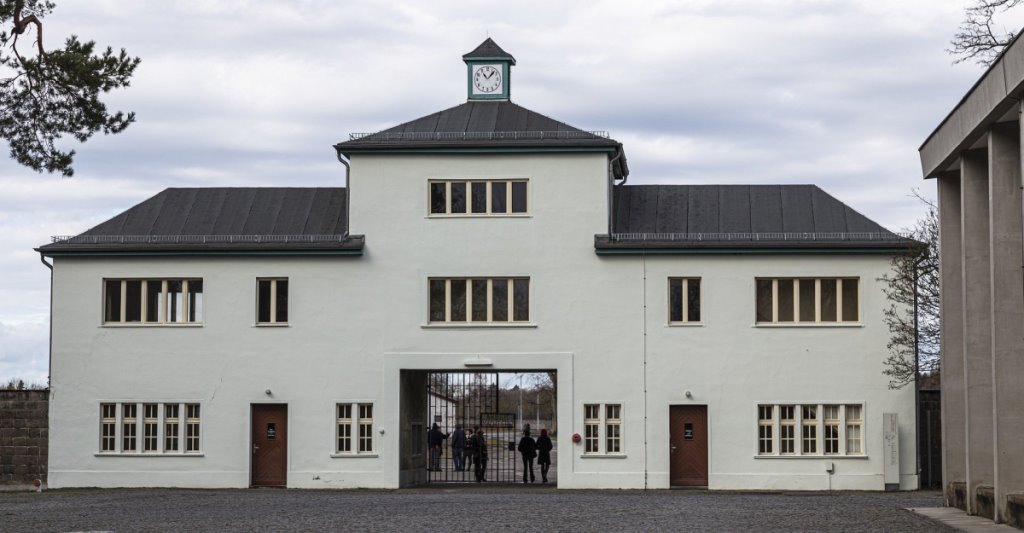
(Copyright 2010 by G.K. Jakobs)
Willy died on 13 July, 1940, in Sachsenhausen, a victim of Nazi persecution. What was Willy’s crime? Why was he imprisoned in Tegel? Why was he sent to Sachsenhausen? We don’t know.
Could his imprisonment have been a consequence of Kristallnacht? Perhaps. Was he someone involved in the black market passport scheme that Josef and others were involved in? The German authorities had arrested around 60 people enmeshed in the scheme and we don’t know the names of all of them. Perhaps Willy was trying to arrange for a foreign passport or visa so that he could leave Germany? He was presumably a moderately wealthy dentist, so might have had the funds to purchase his way out of the country. Or perhaps he chose to sacrifice himself for his son Werner? Perhaps Werner’s escape to Italy was paid for with Willy’s life.
Conclusion
History comes alive in the stories of these people, long dead. In stirring the ashes of their graves, I seek to learn more of the the people touched, and often harmed, by my own grandfather. Josef has always struck me as being a rogue. His money-making schemes seem more intense than I would expect from a devoted husband and father simply trying to support his family. I fear that there was a fair bit of avarice blinding Josef to the suffering, and vulnerability, of those around him.
Josef heard about Werner’s experiment with a new gold alloy and he immediately saw the financial benefits for himself. Werner seems to have been naively honest in informing the German authorities of his creation. But then, Werner was only 22 years old when he and Josef travelled to Switzerland. Young and impressionable? Susceptible to manipulation by the worldly 36 year-old Josef who already had several years of financial shenanigans under his belt? Perhaps they were both naïve, blinded by the golden riches that they saw in their future.
Eight years after their Swiss counterfeiting adventure, Josef would be dead, shot as a spy in the Tower of London and Werner would have fled to Italy. But even in the relative safety of Italy, one throw of the dice could have dire implications.
As the Allies invaded the boot of Italy from the south, their farthest advance in late 1943 would mark the line between life and death. Jews south of that line would live while Jews north of that line would die. Where will we find Werner?
Sources
Ancestry – genealogical documents – births, marriages, deaths, Berlin address books, passenger lists
Digitale Landesbibliothek Berlin site (aka zlb) – digital Berlin address books
Vulcanite Dentures – British Dental Association article
History of Dentures – European Denture Centre
Vulcanite Denture Images – Museum of Design in Plastic (UK)
Gold in Dentistry – Gold Bulletin 2003
Dental Gold Alloys – Gold Bulletin 1981
